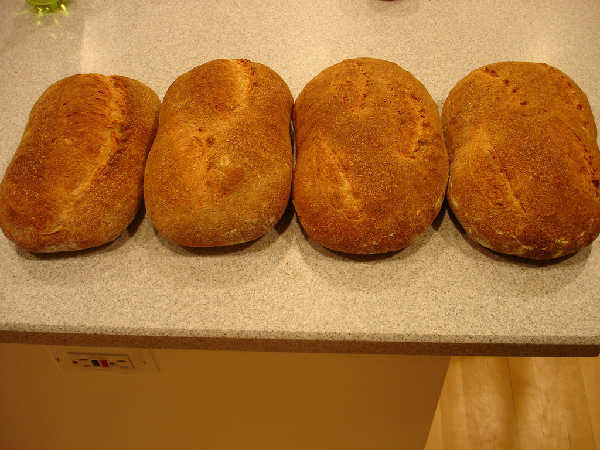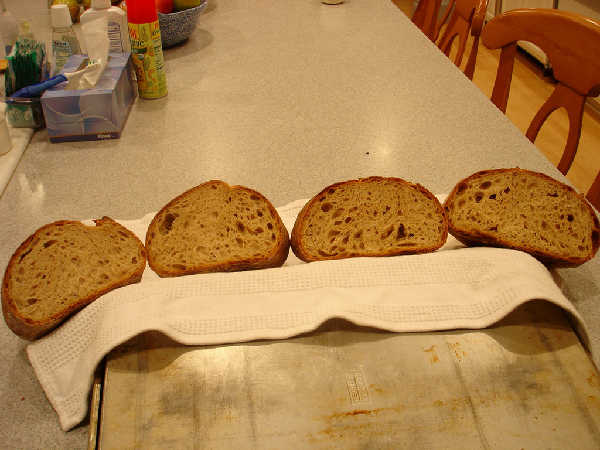I thought it would be interesting to compare four different approaches to sourdough fermentation. I've baked four test loaves, each with 500 grams total flour (using a 50/50 blend of Heartland Mill Strong Bread Flour and Heartland Mill Golden Buffalo for a blended ash content around .85%), 72% overall hydration, and 2% salt. All loaves started with 18 grams 80% hydration white flour storage starter.
The difference in the loaves is in the fermentation method. In one loaf a direct inoculation of storage starter in the final dough (one-step method) was used. In the others a sourdough preferment was built and fermented for different amounts of time. The final loaf includes a spike of instant yeast.
Fermentation Methods Used
- Build final dough including 18 grams of starter, bulk ferment for 11.75 hours, final proof for 3 hours all at about 70F. (xls and html spreadsheets)
- Build a sourdough preferment constituting 35% of total flour and ferment until just doubled, about 8 hours at 70F. Soak remaining final dough ingredients overnight in the refrigerator. Mix preferment and soaker and bulk ferment for 3.75 hours at 70F then final proof for 4 hours at 70F. (xls and html spreadsheets)
- Build sourdough preferment same as in step 2 and ferment for 4 additional hours after it has doubled, about 12 hours at 70F. Proceed same as in step 2. (xls and html spreadsheets)
- Build sourdough preferment same as in step 3. Add 1/4 tsp yeast to soaker. Proceed same as in step 3. (xls and html spreadsheets)
The idea is to compare a long fermentation from an initial very small amount of starter to using a sourdough preferment that is immature (just doubled) or more mature (peaked). Finally, in the last one, the idea is to add in a spike of yeast to improve the rise in the case where a large, mature (35% of total flour and fermented until peaked) preferment is used.
In all cases, the final dough was shaped into a loaf when it had a little less than doubled during bulk fermentation.
Photos of the crust and the crumb from left to right:


Comparison
Crust
I couldn't tell any real difference in the crusts. It's possible the first one was a touch darker than #2 even though both were baked at the same time. Maybe there was a little more enzyme action in it since the entire dough was hydrated at room temperature for about 14 hours.
Crumb
Although they are more similar than different, the crumb was slightly lighter going from 1-4.
For loaf #1, this may again be a function of the enzyme action, which may have in some way hindered the gluten development. Another explanation might be that I needed to fold #1 one or two more times earlier to improve the gluten development over the longer fermentation, as it did seem a little too relaxed at shaping time, relative to the other loaves.
For loaves 2-4, the more mature preferments did not hurt the gluten in this case. I believe the very strong flours contributed to the better results with the more mature preferments. The more mature preferments probably had a larger organism count than the preferment for loaf #2, as they weren't at the collapsing stage yet. So, with higher organism counts, higher fermentation byproducts, but very sourdough tolerant flour, the more mature preferments ended up with slightly larger loaves in the end.
The oven spring went in opposite order to the loaf volume, not surprisingly, which explains why the result after baking is not as different, but the overall loaf volume before baking was significantly larger for loaf #3 than loaves #1 or #2. In the case of loaf #4, the yeast clearly had a big effect on gas production before shaping. I did deflate it a little during shaping, of course. It again was significantly larger pre-bake than loaf #4, but after baking it was only a little bit larger. In summary, the loaf volume before baking increased significantly from loaf 1-4, but the oven spring, which was greater in 1 and much less in 4, offset much of the difference. Nonetheless loaf #4 had a noticeably lighter feeling in the mouth.
Flavor
All of the loaves were fairly mild in flavor. However, without a doubt, loaves #3 and #4 were more sour than loaves #1 and #2. Everyone who I had test the loaves was able to discern the more sour flavors in #3 and #4. There was some debate about the order of #1 versus #2 and #3 versus #4. My youngest son, William, noted a sweetness he seemed to like in loaf #1. I believe he may be detecting, once again, some effect of the enzyme action that was probably greater in that loaf, which soaked for so long at room temperature, and may have resulted in more starch broken down into sugars. My oldest son thought #2 was more sour than #1, which may be correct, given that it had a slightly longer total fermentation time. My son's girlfriend felt the order was 1,2,3,4 from least to most sour, but others had no opinion on #3 versus #4.
Comments
I believe the following are true, all other things, particularly the temperature and amount of enzyme action in the process, being equal.
The difference between #1 and #2 is minimal. You can do a one-step or two-step process timed for convenient stopping points, and the results will be nearly alike, provided that the preferment is not allowed to get very ripe. A two-step process where the preferment is allowed to ripen significantly more will have a more sour flavor.
The least sour result comes from a one-step process run from a very small initial amount of starter.
At some point, I would like to test out effect of temperature in a side by side comparison. I believe if you adjust the fermentation times so that the relative ripeness of the preferments is similar to the loaves above, that the results may not be very different from above. I suspect the slight favoring of lactobacillus versus yeast at temperatures around 65F will have a smaller effect on flavor than overall relative ripeness of preferments and final dough, but I don't know if that test will get done at my house any time soon.







